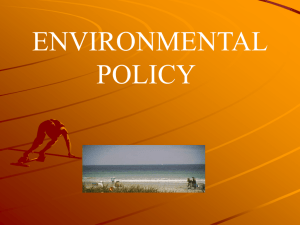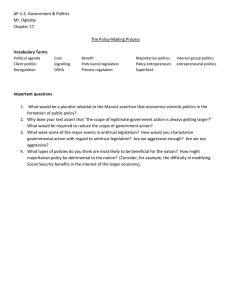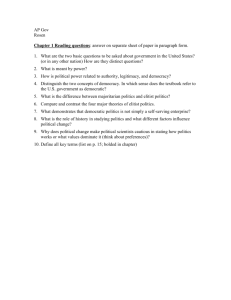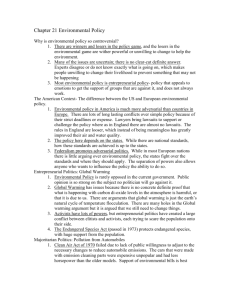Chapter 21 Outline
advertisement
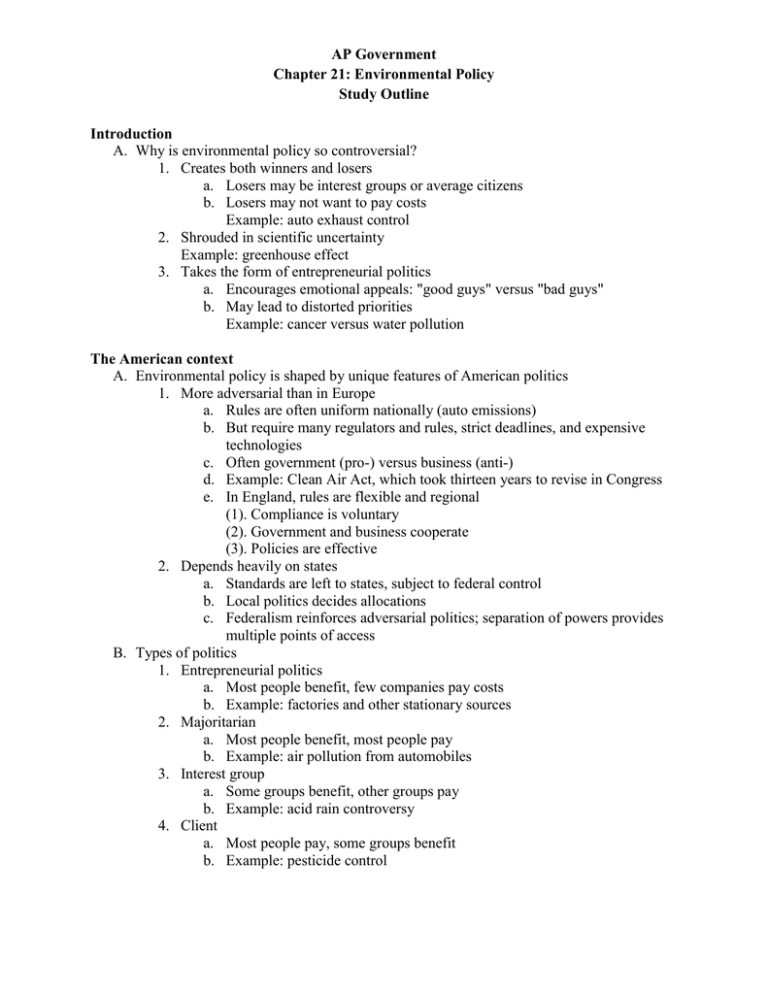
AP Government Chapter 21: Environmental Policy Study Outline Introduction A. Why is environmental policy so controversial? 1. Creates both winners and losers a. Losers may be interest groups or average citizens b. Losers may not want to pay costs Example: auto exhaust control 2. Shrouded in scientific uncertainty Example: greenhouse effect 3. Takes the form of entrepreneurial politics a. Encourages emotional appeals: "good guys" versus "bad guys" b. May lead to distorted priorities Example: cancer versus water pollution The American context A. Environmental policy is shaped by unique features of American politics 1. More adversarial than in Europe a. Rules are often uniform nationally (auto emissions) b. But require many regulators and rules, strict deadlines, and expensive technologies c. Often government (pro-) versus business (anti-) d. Example: Clean Air Act, which took thirteen years to revise in Congress e. In England, rules are flexible and regional (1). Compliance is voluntary (2). Government and business cooperate (3). Policies are effective 2. Depends heavily on states a. Standards are left to states, subject to federal control b. Local politics decides allocations c. Federalism reinforces adversarial politics; separation of powers provides multiple points of access B. Types of politics 1. Entrepreneurial politics a. Most people benefit, few companies pay costs b. Example: factories and other stationary sources 2. Majoritarian a. Most people benefit, most people pay b. Example: air pollution from automobiles 3. Interest group a. Some groups benefit, other groups pay b. Example: acid rain controversy 4. Client a. Most people pay, some groups benefit b. Example: pesticide control Entrepreneurial politics: global warming A. Entrepreneurial politics gave rise to environmental movement 1. Santa Barbara oil spill, Earth Day 2. Led to the formation of EPA and passage of the Water Quality Improvement Act and tougher Clean Air Act in 1970 3. Two years later Congress passed laws designed to clean up water 4. Three years later Congress adopted the Endangered Species Act 5. New laws passed into the 1990s 6. Existing environmental organizations grew in size and new ones formed 7. Public opinion rallied behind environmental slogans B. Global warming 1. Earth's temperature rises from trapped gases in the atmosphere 2. Predicted result: floods on coastal areas as the polar ice caps melt; wilder weather as more storms are created; and tropical diseases spread to North America 3. Activist scientists versus skeptics scientists a. Activists agree with predicted results and say we should act now, despite scientific doubts b. Skeptics say we should learn more before doing anything c. Survey indicates skeptics outnumber activists 4. Activists have greatest influence 5. U.S. signed Kyoto Protocol in 1997 C. Endangered species 1. Endangered Species Act of 1973 prohibits buying or selling plants or animals on "endangered" species list 2. Over six hundred species on list with about half plants 3. Firms and government agencies seeking to build in areas with endangered species must comply with federal regulations 4. Complaints outweigh public support for law Majoritarian politics: pollution from automobiles A. Clean Air Act imposed tough restrictions 1. Public demanded improvements 2. 1975: 90 percent reduction of hydrocarbons and carbon monoxide 3. 1976: 90 percent reduction in nitrous oxides 4. Required catalytic converters B. Emergence of majoritarian politics in auto pollution 1. States were required to restrict public use of cars a. If auto emissions controls were insufficient--Los Angeles, Denver, New York-- parking bans required, implementation of car pools, gas rationing b. Efforts failed: opposition too great c. Congress and the EPA backed down, postponed deadlines 2. Consumers, auto industry, and unions objected a. Loss of horsepower b. Loss of competitiveness c. Loss of jobs 3. The Clean Air Act was weakened in 1977 but revived in 1990 with tougher standards C. Public will support tough laws 1. If costs are hidden (catalytic converters) 2. But not if they have to change habits (car pools) D. Majoritarian politics when people believe the costs are low: National Environmental Policy Act of 1969 (NEPA) 1. Requires environmental impact statement (EIS) 2. Does not require specific action 3. Passed Congress with overwhelming support 4. But encouraged numerous lawsuits that block or delay projects 5. Popular support remains strong: costs appear low, benefits high E. Majoritarian politics when people believe the costs are high 1. Increased gasoline taxes a. Would discourage driving, save fuel, and reduce smog b. Most would pay, most would benefit c. But costs come long before benefits d. And benefits may not be obvious 2. Easier to raise gas tax if benefits are concrete, for example, highways, bridges, and so forth Interest group politics: acid rain A. Source of acid rain 1. Burning of high-sulfur coal in midwestern factories 2. Winds carry sulfuric acid eastward 3. Rains bring acid to earth B. Effects of acid rain 1. Acidification of lakes 2. Destruction of forests 3. Long-term and some short-term effects are unclear C. Regional battle 1. East versus Midwest, Canada versus United States 2. Midwestern businesses deny blame and costs D. Solutions and compromise 1. Burn low-sulfur coal one alternative a. Effective but expensive b. Low-sulfur coal comes from West, high-sulfur coal is local 2. Install smokestack scrubbers a second alternative a. Costly, not always effective, and leave sludge b. But allow use of inexpensive high-sulfur coal 3. Congress voted for scrubbers for all new plants a. Including those that burned low-sulfur coal b. Even if plant was next to low-sulfur coal mine 4. Political advantages a. Protected jobs of high-sulfur coal miners; powerful allies in Congress b. Environmentalists preferred scrubbers; "definitive" solution to problem c. Scrubber manufacturers preferred scrubbers d. Eastern governors preferred scrubbers; made their plants more competitive 5. Practical disadvantages a. Failed to allow for plants that burn low-sulfur coal; why spend money on scrubbers? b. Scrubbers didn't work well c. Failed to address problem of existing plants 6. Stalemate for thirteen years 7. Two-step regulation proposed by Bush a. Before 1995: some plants could choose their approach; fixed reduction but plants decide how to do b. After 1995: sharper reductions for many more plants, requiring some use of scrubbers c. Sulfur dioxide allowances could be bought and sold d. Financial compensation for coal miners who lose jobs 8. Became part of Clean Air Act of 1990 E. Another example of interest group politics: zoning regulations, residents versus developers F. New interest groups 1. More fervent and committed than before 2. Able to block change in policies 3. Examples a. Environmental protection industry b. Environmental Defense Fund c. Labor unions 4. Momentum remains with policy makers Client politics: agricultural pesticides A. Issue: control of use and runoff of pesticides; farmers have mostly resisted policy entrepreneurs, with DDT an exception B. EPA efforts to evaluate safety of all pesticides 1. Given mandate by Congress in 1972 2. Program has not succeeded a. Too many pesticides to evaluate (1). Many have only long-term effects needing extended study (2). Expensive and time-consuming to evaluate b. Benefits of pesticide may outweigh harm 3. Political complications a. Farmers are well-represented in Congress b. Subsidies encourage overproduction, which encourages overuse of pesticides c. Damage is hard to see and dramatize 4. The EPA budget is small 5. Few pesticides have been removed from the market; only those receiving heavy media coverage such as DDT in 1972 6. Client politics has won out C. Environmentalists versus loggers 1. Issue: clear-cutting of forests 2. Congress has supported loggers a. Forest Service forced to sell lumber at below-market prices b. Subsidizes industry 3. Spotted owl: getting the media involved--entrepreneurial politics The environmental uncertainties A. Why is it so difficult to have a sane environmental policy? 1. Many environmental problems are not clear cut 2. Goals are often unclear; public opinion can shift 3. Means of achieving goals (command-and-control strategy) are complicated by a. Local circumstances b. Technological problems c. Economic costs B. Examples of EPA and politics 1. What is the problem? a. The EPA not left alone to define problem b. Scandals and congressional demands can shift priorities 2. What are our goals? a. Many are completely unrealistic b. The EPA forced to ask for extensions and revisions 3. How do we achieve our goals? a. Rules have been replaced by incentives (1). Offsets (2). Bubble standards (3). Pollution allowances b. Complaints about command-and-control strategy are now coming from environmental groups and government (1). Clinton administration is reexamining old approaches (2). People are learning from experience The results: the environment has improved since 1970 in some aspects A. Less air pollution B. Maybe less water pollution but harder to judge C. Hazardous wastes remain a problem

